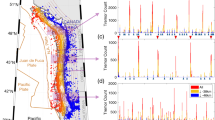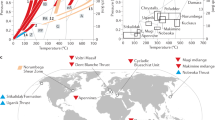Abstract
Slow slip forms part of the spectrum of fault behaviour between stable creep and destructive earthquakes1,2. Slow slip occurs near the boundaries of large earthquake rupture zones3,4 and may sometimes trigger fast earthquakes2. It is thought to occur in faults comprised of rocks that strengthen under fast slip rates, preventing rupture as a normal earthquake, or on faults that have elevated pore-fluid pressures5,6,7. However, the processes that control slow rupture and the relationship between slow and normal earthquakes are enigmatic. Here we use laboratory experiments to simulate faulting in natural rock samples taken from shallow parts of the Nankai subduction zone, Japan, where very low-frequency earthquakes—a form of slow slip—have been observed8,9,10. We find that the fault rocks exhibit decreasing strength over millimetre-scale slip distances rather than weakening due to increasing velocity. However, the sizes of the slip nucleation patches in our laboratory simulations are similar to those expected for the very low-frequency earthquakes observed in Nankai. We therefore suggest that this type of fault-weakening behaviour may generate slow earthquakes. Owing to the similarity between the expected behaviour of slow earthquakes based on our data, and that of normal earthquakes during nucleation, we suggest that some types of slow slip may represent prematurely arrested earthquakes.
This is a preview of subscription content, access via your institution
Access options
Subscribe to this journal
Receive 12 print issues and online access
$259.00 per year
only $21.58 per issue
Buy this article
- Purchase on Springer Link
- Instant access to full article PDF
Prices may be subject to local taxes which are calculated during checkout




Similar content being viewed by others
References
Ide, S., Beroza, G. C., Shelly, D. R. & Uchide, T. A scaling law for slow earthquakes. Nature 447, 76–79 (2007).
Peng, Z. & Gomberg, J. An integrated perspective of the continuum between earthquakes and slow-slip phenomena. Nature Geosci. 3, 599–607 (2010).
Hyndman, R. D. in The Seismogenic Zone of Subduction Thrust Faults (eds Dixon, T. H. & Moore, J. C.) 15–40 (Columbia Univ. Press, 2007).
Chapman, J. S. & Melbourne, T. I. Future Cascadia megathrust rupture delineated by episodic tremor and slip. Geophys. Res. Lett. 36, L22301 (2009).
Segall, P., Rubin, A. M., Bradley, A. M. & Rice, J. R. Dilatant strengthening as a mechanism for slow slip events. J. Geophys. Res. 115, B12305 (2010).
Liu, Y. & Rice, J. R. Slow slip predictions based on granite and gabbro friction data compared to GPS measurements in northern Cascadia. J. Geophys. Res. 114, B09407 (2009).
Shibazaki, B. & Shimamoto, T. Modeling of short-interval silent slip events in deeper subduction zone interfaces considering the frictional properties at the unstable–stable transition regime. Geophys. J. Int. 171, 191–205 (2007).
Obara, K. & Ito, Y. Very low frequency earthquakes excited by the 2004 off the Kii Peninsula earthquakes: A dynamic deformation process in the large accretionary prism. Earth Planets Space. 57, 321–326 (2005).
Ito, Y. & Obara, K. Very low frequency earthquakes within accretionary prisms are very low stress-drop earthquakes. Geophys. Res. Lett. 33, L09302 (2006).
Sugioka, H. et al. Tsunamigenic potential of the shallow subduction plate boundary inferred from slow seismic slip. Nature Geosci. 5, 414–418 (2012).
Kodaira, S. et al. High pore fluid pressure may cause silent slip in the Nankai Trough. Science 304, 1295–1298 (2004).
Rubin, A. M. Designer friction laws for bimodal slow slip propagation speeds. Geochem. Geophys. Geosyst. 12, Q04007 (2011).
Moore, G. F. et al. Proc. ODP, Init. Repts. Vol. 190, College Station, TX (Ocean Drilling Program, 2001).
Kinoshita, M. et al. Proc. IODP Vols 314/315/316, Washington, D.C. (Integrated Ocean Drilling Program Management International, 2009).
Kitajima, H. & Saffer, D. M. Elevated pore pressure and anomalously low stress in regions of low frequency earthquakes along the Nankai subduction megathrust. Geophys. Res. Lett. 39, L23301 (2012).
Dieterich, J. H. in Mechanical Behavior of Crustal Rocks Vol. 24 (eds Carter, N. L. et al.) 102–120 (Geophys. Monogr. Ser., 1981).
Marone, C. Laboratory-derived friction laws and their application to seismic faulting. Annu. Rev. Earth Planet. Sci. 26, 643–696 (1998).
Scholz, C. H. The Mechanics of Earthquakes and Faulting 2nd edn (Cambridge Press, 2002).
Roy, M. & Marone, C. Earthquake nucleation on model faults with rate- and state-dependent friction: Effects of inertia. J. Geophys. Res. 101, 13919–13932 (1996).
Perfettini, H. & Ampuero, J-P. Dynamics of a velocity-strengthening fault region: Implications for slow earthquakes and postseismic slip. J. Geophys. Res. 113, B09411 (2008).
Linde, A. T., Gladwin, M. T., Johnston, M. J. S., Gwyther, R. L. & Bilham, R. G. A slow earthquake sequence on the San Andreas fault. Nature 383, 65–68 (1996).
Crescentini, L., Amoruso, A. & Scarpa, R. Constraints on slow earthquake dynamics from a swarm in Central Italy. Science 286, 2132–2134 (1999).
Hirose, H., Hirahara, K., Kimata, F., Fujii, N. & Miyazaki, S. A slow thrust slip event following the two 1996 Hyuganada earthquakes beneath the Bungo Channel, southwest Japan. Geophys. Res. Lett. 26, 3237–3240 (1999).
Ikari, M. J. & Saffer, D. M. Comparison of frictional strength and velocity dependence between fault zones in the Nankai accretionary complex. Geochem. Geophys. Geosyst. 12, Q0AD11 (2011).
Blanpied, M. L., Marone, C. J., Lockner, D. A., Byerlee, J. D. & King, D.P. Quantitative measure of the variation in fault rheology due to fluid-rock interactions. J. Geophys. Res. 103, 9691–9712 (1998).
Ohnaka, M. A physical scaling relation between the size of an earthquake and its nucleation zone size. Pure Appl. Geophys. 157, 2259–2282 (2000).
Brodsky, E. E. & Mori, J. Creep events slip less than ordinary earthquakes. Geophys. Res. Lett. 34, L16309 (2007).
Ellsworth, W. L. & Beroza, G. C. Seismic evidence for an earthquake nucleation phase. Science 286, 851–855 (1995).
Iio, Y. Observations of the slow initial phase generated by microearthquakes: Implications for earthquake nucleation and propagation. J. Geophys. Res. 100, 15333–15349 (1995).
Saffer, D. M. & Tobin, H. J. Hydrogeology and mechanics of subduction zone forearcs: Fluid flow and pore pressure. Annu. Rev. Earth. Planet. Sci. 39, 157–186 (2011).
Logan, J. M., Dengo, C. A., Higgs, N. G. & Wang, Z. Z. in Fault Mechanics and Transport Properties of Rocks (eds Evans, B. & Wong, T-F.) 33–67 (Academic, 1992).
Acknowledgements
We thank N. De Paola for constructive comments, which improved this manuscript. This work was supported by NSF awards OCE-0451602, OCE-0752114 and OCE-0648331 to D.M.S. and C.M., and by Deutsche Forschungsgemeinschaft (DFG) through the MARUM Research Center.
Author information
Authors and Affiliations
Contributions
M.J.I conducted experiments and data analysis. All authors contributed to planning and writing the manuscript, and providing support.
Corresponding author
Ethics declarations
Competing interests
The authors declare no competing financial interests.
Rights and permissions
About this article
Cite this article
Ikari, M., Marone, C., Saffer, D. et al. Slip weakening as a mechanism for slow earthquakes. Nature Geosci 6, 468–472 (2013). https://doi.org/10.1038/ngeo1818
Received:
Accepted:
Published:
Issue Date:
DOI: https://doi.org/10.1038/ngeo1818
This article is cited by
-
Weakening behavior of the shallow megasplay fault in the Nankai subduction zone
Earth, Planets and Space (2022)
-
Slow slip events following the afterslip of the 2002 Mw 7.1 Hualien offshore earthquake, Taiwan
Earth, Planets and Space (2022)
-
Linking the scaling of tremor and slow slip near Parkfield, CA
Nature Communications (2022)
-
Creep-dilatancy development at a transform plate boundary
Nature Communications (2022)
-
Integrated rupture mechanics for slow slip events and earthquakes
Nature Communications (2022)



